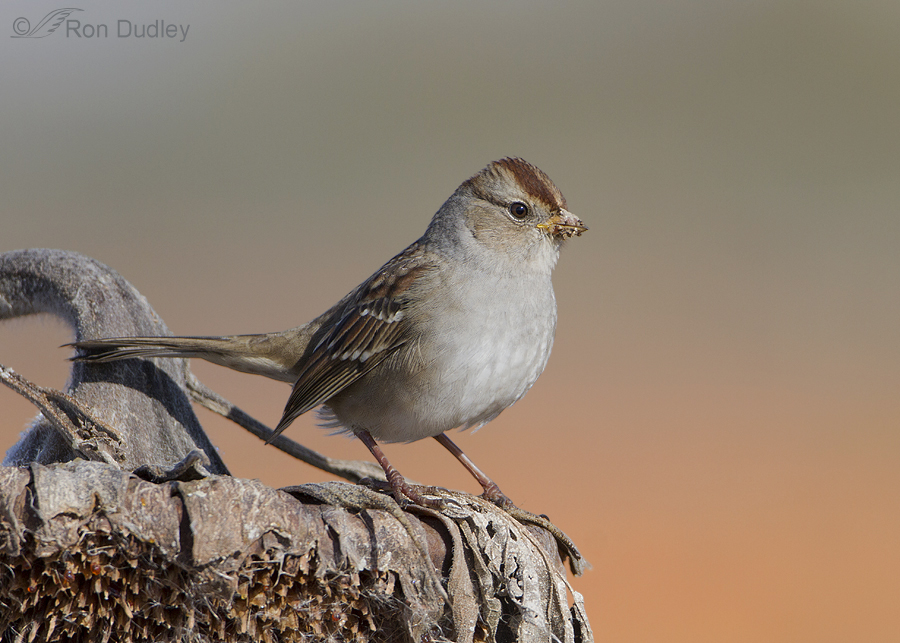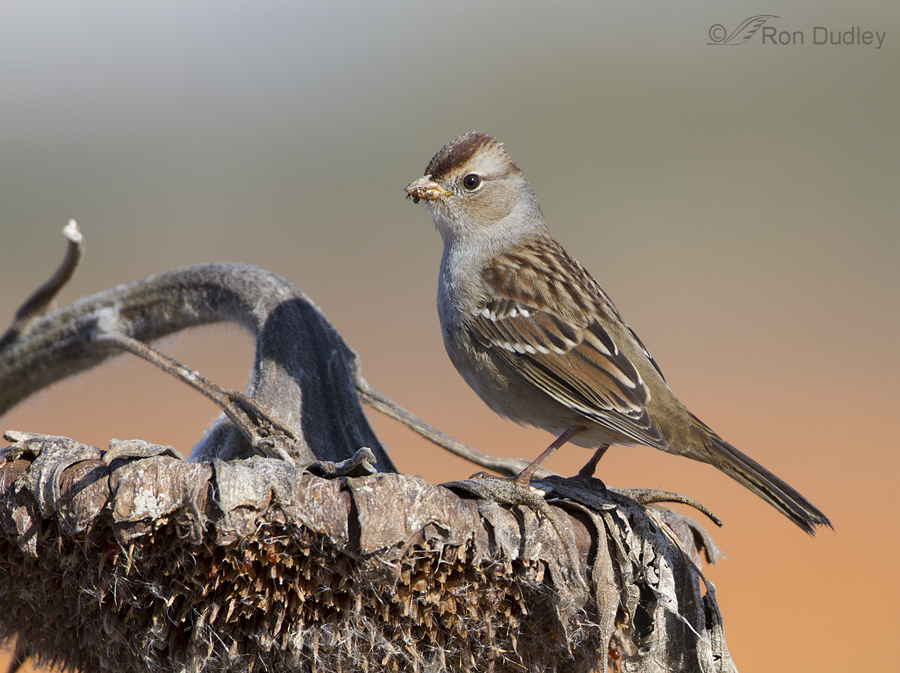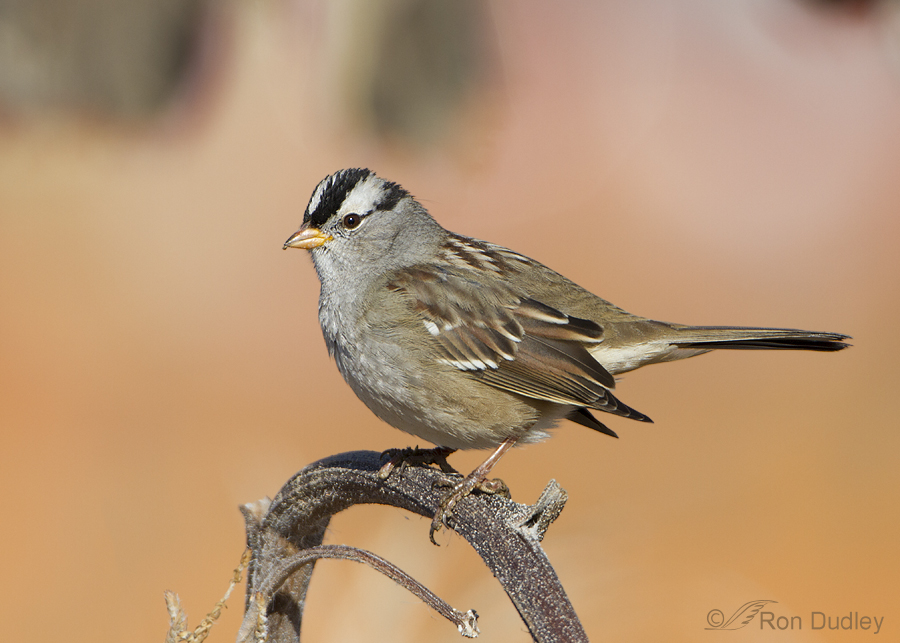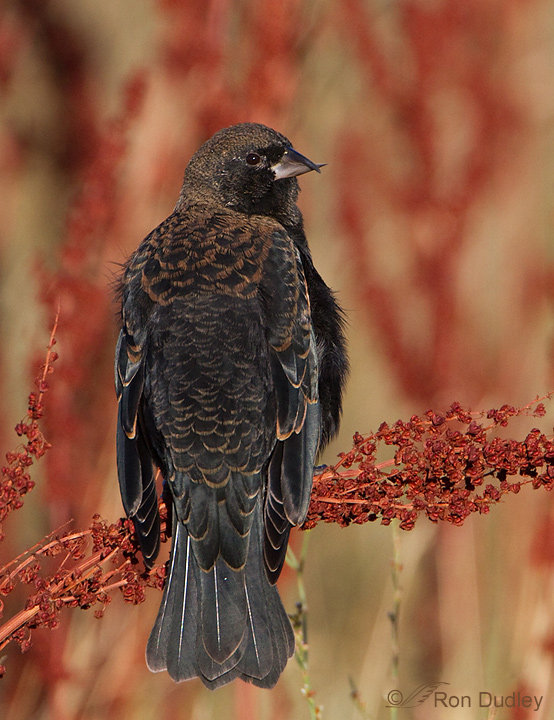A local pumpkin farmer (Pack Farms) plants sunflowers along the periphery of his pumpkin field and each fall they provide a messy bounty for a variety of birds. Most species seem to be tidy eaters but the juvenile White-crowned Sparrows are an exception.
The orange in the background of these shots is – you guessed it – pumpkins.
1/1000, f/7.1, ISO 500, 500 f/4, 1.4 tc, natural light
There must be something sticky holding the sunflower seeds in place because the sparrows sure seem to make a mess of their beak while dining. For some reason I don’t see the same thing happen with blackbirds – perhaps sparrows are just untidy eaters.
1/1000, f/7.1, ISO 500, 500 f/4, 1.4 tc, natural light
Another possibility (tongue in cheek) is that the juveniles (brown crown-stripes) just haven’t yet had time to develop proper table manners. Virtually all of the juveniles feeding on the sunflowers had food-encrusted beaks while …
1/1600, f/6.3, ISO 500, 500 f/4, 1.4 tc, natural light
the adults (black crown-stripe) were much more tidy.
Notice that this bird has crossed mandible tips, similar to the crossed bills of Red and White-winged Crossbills who use their unique bills to pry conifer seeds out of their cones.
It’s just a coincidence that this sparrow with a crossed bill was using a food source that, like conifer seeds, must to some degree be pried out of its “container” but it was a coincidence that I did notice.
Crossed bills show up occasionally in a variety of species for which it’s not “normal”. This Red-winged Blackbird is a prime example.
Which makes me wonder if such a variation was the evolutionary “fuel” for the species trait in Crossbills.
Ron






hm-m-m…interesting!
In rehab, I once got in a nestling red-winged blackbird with a beak so severely crossed that he could not eat; also a great blue heron. There have been incidences in various places, like CA and the Great Lakes, where a large number of birds like cormorants have showed up with beak deformities – eventually linked to pesticides, if I remember correctly. Now there is Long billed Syndrome in red-tailed hawks (in CA, OR and WA), chickadees (in Alaska), and some other species. So far the researchers are stumped – the hawks I’ve gotten in are sent to Washington State University in eastern WA. So not all is likely to be evolutionarily based … These birds have a really hard time eating. The first red-tail I got in with a hugely long beak (he had his beak stuck in a very heavy cow liver and couldn’t get it out; the rescuer brought him in with the liver!) was before I heard of the syndrome – we simply trimmed and shaped the beak and released him. Others have come in wildly thin and debilitated. The researchers even want live birds – it would have been interesting to see if the beak on that first bird regrew over long again.a. Normally birds in the wild (dirty-beaked young sparrows notwithstanding) DO feak on a hard surface after every meal, keeping their beaks well shaped.
Sunflower seed seems to be a much loved food source everywhere. I know that our farmers curse some of the birds fondness for them. A large flock of cockatoos can (and do) wreak havoc.
Loved the messy eaters. Thanks.
I can just hear Mama White-crowned tweeping “Oh, go feak your beak, right NOW! That Ron guy is taking photos! Do you want to have your picture posted on the web looking like that? You’ll never get a girl-friend! Good grief!”
“Good grief” – sounds like something my own mother would have told me, Mikal…
A few years ago I took pictures of a juvenile bald eagle that had a half cross bill. The lower portion of its beak was long and straight and the upper curved as normal but because the lower was much longer the upper crossed over. My pics weren’t great due to overcast, foggy days but you can see the cross.
A Bald Eagle with a partially crossed bill – how interesting, Tanja.
More fabulous, crystal clear photos. I love the juveniles witht he seed all over their beaks. So much fun to watch the young ins!!!! I always wondered about cross beaks. As ususal thanks for teaching me so much Ron. I’ve enver seen a red-winged blackbird. We have other types of black birds. None as pretty as this one. But it was probably your huge skills as a photographer that make him/her look so beautiful!
Ellen
Ellen, sometimes I have to be reminded that not everyone sees all of the very common birds in my area. Red-winged Blackbirds are striking birds but I sometimes take them for granted. Shouldn’t…
Beautiful images…love the backgrounds and the contrasting textures of birds and plants, especially the hard, dry, slightly prickly arch of the sunflower stem and the orange “haze”…and the “flames” behind the blackbird. Interesting theory about the crossed bills…they all look overstuffed…or was it chilly?
It wasn’t particularly cold, Patty. I guess I just happened to catch two of them a little fluffed up.
Wonderful shots and info Ron!
Charlotte
Thank you, Charlotte.
What precise, beautiful photos, even the sloppy guys. The background here far surpasses the scrub and bramble against which I usually see them. Extraordinarily beautiful photography.
Thanks, Kelly. I thought the background was pretty interesting in an unusual sort of way, too.
Beautiful shots Ron particularly with the autumn colors as the background. Just recently started following your awesome blog.Your photography is simply outstanding !
Tim
Welcome, Tim. And thank you for the kind words.